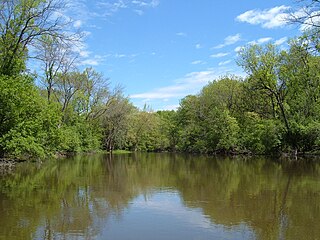
The Chicago River is a system of rivers and canals with a combined length of 156 miles (251 km) that runs through the city of Chicago, including its center. Though not especially long, the river is notable because it is one of the reasons for Chicago's geographic importance: the related Chicago Portage is a link between the Great Lakes and the Mississippi River Basin, and ultimately the Gulf of Mexico.

The Illinois River is a principal tributary of the Mississippi River and is approximately 273 miles (439 km) long. Located in the U.S. state of Illinois, the river has a drainage basin of 28,756.6 square miles (74,479 km2). The Illinois River begins with the confluence of the Des Plaines and Kankakee rivers in the Chicago metropolitan area, and it generally flows to the southwest across Illinois, until it empties into the Mississippi near Grafton, Illinois. Its drainage basin extends into southeastern Wisconsin, northwestern Indiana, and a very small area of southwestern Michigan in addition to central Illinois. Along its shores are several river ports, including Peoria, Illinois. Historic recreation areas on the river include Starved Rock and the internationally important wetlands of the Emiquon Complex and Dixon Waterfowl Refuge.
Myers v. United States, 272 U.S. 52 (1926), was a United States Supreme Court decision ruling that the President has the exclusive power to remove executive branch officials, and does not need the approval of the Senate or any other legislative body. It was distinguished in 1935 by Humphrey's Executor v. United States. However, in Seila Law LLC v. Consumer Financial Protection Bureau (2020), the Supreme Court interpreted Myers as establishing that the President generally has unencumbered removal power. Myers was the first Supreme Court case to address the president's removal powers.

The United States Court of Appeals for the Seventh Circuit is the U.S. federal court with appellate jurisdiction over the courts in the following districts:

The Chicago Sanitary and Ship Canal, historically known as the Chicago Drainage Canal, is a 28-mile-long (45 km) canal system that connects the Chicago River to the Des Plaines River. It reverses the direction of the Main Stem and the South Branch of the Chicago River, which now flows out of Lake Michigan rather than into it. The related Calumet-Saganashkee Channel does the same for the Calumet River a short distance to the south, joining the Chicago canal about halfway along its route to the Des Plaines. The two provide the only navigation for ships between the Great Lakes Waterway and the Mississippi River system.

The Des Plaines River is a river that flows southward for 133 miles (214 km) through southern Wisconsin and northern Illinois in the United States Midwest, eventually meeting the Kankakee River west of Channahon to form the Illinois River, a tributary of the Mississippi River.
The Judiciary Act of 1925, also known as the Judge's Bill or Certiorari Act, was an act of the United States Congress that sought to reduce the workload of the Supreme Court of the United States.

Myra Colby Bradwell was an American publisher and political activist. She attempted in 1869 to become the first woman to be admitted to the Illinois bar to practice law, but was denied admission by the Illinois Supreme Court in 1870 and the United States Supreme Court in 1873, in rulings upholding a separate women's sphere. Bradwell had founded and published Chicago Legal News from 1868, reporting on the law and continued that work. Meanwhile, influenced by her case, in 1872 the Illinois legislature passed a state law prohibiting gender discrimination in admission to any occupation or profession.
Terminiello v. City of Chicago, 337 U.S. 1 (1949), was a case in which the Supreme Court of the United States held that a "breach of peace" ordinance of the City of Chicago that banned speech that "stirs the public to anger, invites dispute, brings about a condition of unrest, or creates a disturbance" was unconstitutional under the First and Fourteenth Amendments to the United States Constitution.
Taft v. Bowers, 278 U.S. 470 (1929), was a case heard before the United States Supreme Court dealing with taxation of a gift of shares of stock under the Sixteenth Amendment to the United States Constitution. The recipient of shares of stock, Elizabeth Taft, argued that she could not be taxed on the amount that the gift increased in value before she received it. She agreed that the IRS could tax the increase in value of the gift that occurred after her receipt of the gift.
Drainage districts occur in England and Wales, varying in size from a few hundred acres to over 100,000 acres (400 km2), all in low-lying areas of the country where flood risk management and land drainage are sensitive issues. Most drainage districts are administered by an internal drainage board (IDB), which are single purpose local drainage authorities, dealing with the drainage and water level management of clean water only. Each drainage district has a defined area, and the IDB only has powers to deal with matters affecting that area.
Ableman v. Booth, 62 U.S. 506 (1859), was a United States Supreme Court case in which the Court unanimously held that state courts cannot issue rulings that contradict the decisions of federal courts, overturning a decision by the Supreme Court of Wisconsin. The Court found that under the Constitution, federal courts have the final power to decide cases arising under the Constitution and federal statutes, and that the States do not have the power to overturn those decisions. Thus, Wisconsin did not have the authority to nullify federal judgments or statutes. For example, it is illegal for state officials to interfere with the work of U.S. Marshals acting under federal laws. The Ableman decision emphasized the dual form of American government and the independence of State and federal courts from each other.

Willis Van Devanter was an American lawyer who served as an associate justice of the Supreme Court of the United States from 1911 to 1937. He was a staunch conservative and was regarded as a part of the Four Horsemen, the conservative bloc which dominated the Supreme Court during the 1930s.

Edward Terry Sanford was an American jurist who served as an associate justice of the Supreme Court of the United States from 1923 until his death in 1930. Prior to his nomination to the high court, Sanford served as a United States Assistant Attorney General under President Theodore Roosevelt from 1905 to 1907, and as a United States district judge of the United States District Court for the Eastern District of Tennessee and the United States District Court for the Middle District of Tennessee from 1908 to 1923. As of 2023, he is the last sitting district court judge to be elevated directly to the Supreme Court.
McDonald v. City of Chicago, 561 U.S. 742 (2010), was a landmark decision of the Supreme Court of the United States that found that the right of an individual to "keep and bear arms", as protected under the Second Amendment, is incorporated by the Due Process Clause of the Fourteenth Amendment and is thereby enforceable against the states. The decision cleared up the uncertainty left in the wake of District of Columbia v. Heller (2008) as to the scope of gun rights in regard to the states.
Harris v. Quinn, 573 U.S. 616 (2014), is a US labor law case of the United States Supreme Court regarding provisions of Illinois state law that allowed a union security agreement. Since the Taft-Hartley Act of 1947 prohibited the closed shop, states could still choose whether to allow unions to collect fees from non-union members since the collective agreements with the employer would still benefit non-union members. The Court decided 5–4 that Illinois's Public Labor Relations Act, which permitted the union security agreements, violated the First Amendment. A similar case was decided by the Court in 2018, Janus v AFSCME, overturning the Court's unanimous decision in Abood v. Detroit Board of Education (1977) which the appeals court had upheld in Harris.

The Chicago Area Waterway System (CAWS) is a complex of natural and artificial waterways extending through much of the Chicago metropolitan area, covering approximately 87 miles altogether. It straddles the Chicago Portage and is the sole navigable inland link between the Great Lakes and the Mississippi River and makes up the northern end of the Illinois Waterway.
United States v. Jones, 109 U.S. 513 (1883), is an important decision by the United States Supreme Court which provides the power to take private property for public uses, in the exercise of the right of eminent domain, to the government of the United States. However, once the government exercises of the right of eminent domain and after a fair determination of the amount of compensation, any unforeseen damage to the property as a result of activities prior to the purchase but realized only afterwards is to be compensated by the government per any legislative decree.
Janus v. American Federation of State, County, and Municipal Employees, Council 31, No. 16-1466, 585 U.S. ___ (2018), abbreviated Janus v. AFSCME, was a landmark decision of the US Supreme Court on US labor law, concerning the power of labor unions to collect fees from non-union members. Under the Taft–Hartley Act of 1947, which applies to the private sector, union security agreements can be allowed by state law. The Supreme Court ruled that such union fees in the public sector violate the First Amendment right to free speech, overturning the 1977 decision in Abood v. Detroit Board of Education that had previously allowed such fees.









